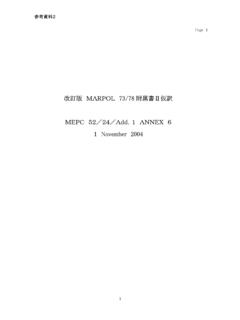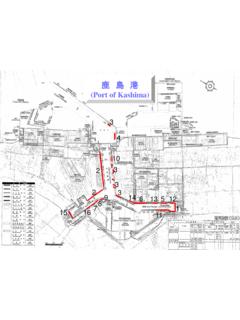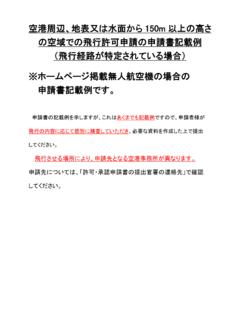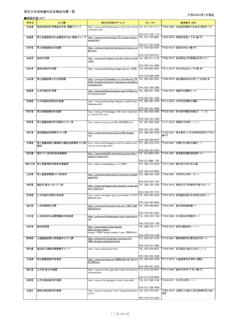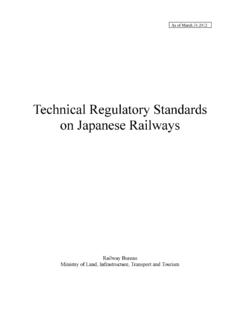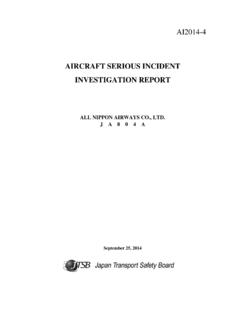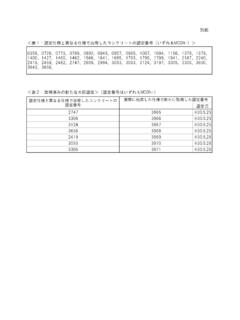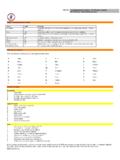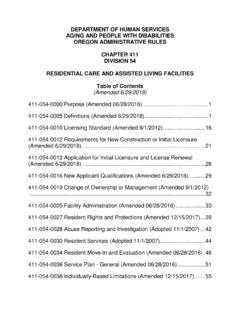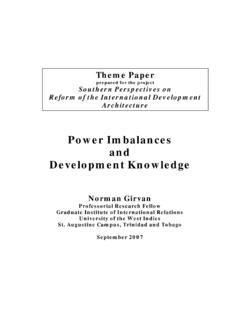Transcription of AIRCRAFT ACCIDENT INVESTIGATION REPORT - …
1 AA2013-4. AIRCRAFT ACCIDENT . INVESTIGATION REPORT . FEDERAL EXPRESS CORPORATION. N 5 2 6 F E. April 26, 2013. Note: This REPORT is a translation of the Japanese original INVESTIGATION REPORT . The text in Japanese shall prevail in the interpretation of the REPORT . The objective of the INVESTIGATION conducted by the Japan Transport Safety Board in accordance with the Act for Establishment of the Japan Transport Safety Board and with Annex 13 to the Convention on International Civil Aviation is to determine the causes of an ACCIDENT and damage incidental to such an ACCIDENT , thereby preventing future accidents and reducing damage. It is not the purpose of the INVESTIGATION to apportion blame or liability. Norihiro Goto Chairman, Japan Transport Safety Board AIRCRAFT ACCIDENT INVESTIGATION REPORT . CRASH DURING LANDING. FEDERAL EXPRESS CORPORATION. MCDONNELL DOUGLAS MD-11F, N526FE. NARITA INTERNATIONAL AIRPORT.
2 MARCH 23, 2009. April 5, 2013. Adopted by the Japan Transport Safety Board Chairman Norihiro Goto Member Shinsuke Endoh Member Toshiyuki Ishikawa Member Sadao Tamura Member Yuki Syuto Member Keiji Tanaka SYNOPSIS. Summary of the ACCIDENT On March 23 (Monday), 2009, about 06:49 local time*1, a McDonnell Douglas MD-11F, registered N526FE, operated by Federal Express Corporation as the scheduled cargo flight FDX80, bounced repeatedly during landing on Runway 34L at Narita International Airport. During the course of bouncing, its left wing was broken and separated from the fuselage attaching point and the airplane caught fire. The airplane rolled over to the left being engulfed in flames, swerved off the runway to the left and came to rest inverted in a grass area. The Pilot in Command (PIC) and the First Officer (FO) were on board the airplane, and both of them suffered fatal injuries. The airplane was destroyed and the post-crash fire consumed most parts.
3 Probable Causes In this ACCIDENT , when the airplane landed on Runway 34L at Narita International Airport, it fell into porpoising. It is highly probable that the left wing fractured as the load transferred from the left MLG to the left wing structure on the third touchdown surpassed the design limit (ultimate load). It is highly probable that a fire broke out as the fuel spillage from the left wing caught fire, and the airplane swerved left off the runway rolling to the left and came to rest inverted on the grass area. The direct causes which the airplane fell into the porpoise phenomenon are as follows: a. Large nose-down elevator input at the first touchdown resulted in a rapid nose down motion during the first bounce, followed by the second touchdown on the NLG with negative pitch attitude. Then the pitch angle rapidly increased by the ground reaction force, causing the larger second bounce, and b.
4 The PF s large elevator input in an attempt to control the airplane without thrust during the second bounce. In addition, the indirect causes are as follows: a. Fluctuating airspeed, pitch attitude due to gusty wind resulted in an approach with a large sink rate, b. Late flare with large nose-up elevator input resulted in the first bounce and c. Large pitch attitude change during the bounce possibly made it difficult for the crewmembers to judge airplane pitch attitude and airplane height relative to the ground (MLG height above the runway). d. The PM s advice, override and takeover were not conducted adequately. It is somewhat likely that, if the fuse pin in the MLG support structure had failed and the MLG had been separated in the overload condition in which the vertical load is the primary component, the damage to the fuel tanks would have been reduced to prevent the fire from developing rapidly.
5 It is probable that the fuse pin did not fail because the failure mode was not assumed under an overload condition in which the vertical load is the primary component due to the *1 Japan Standard Time (JST): UTC + 9hr, unless otherwise stated all times are indicated in JST on a 24-hour clock. interpretation of the requirement at the time of type certification for the MD-11 series airplanes. Safety Recommendations On March 23 (Monday), 2009, about 06:49 JST (Japan Standard Time), a McDonnell Douglas MD-11F, registered N526FE, operated by Federal Express Corporation as the scheduled cargo flight FDX80, bounced repeatedly during landing on Runway 34L at Narita International Airport. During the course of bouncing, its left wing was broken and the airplane caught fire. The airplane rolled over to the left being engulfed in flames, swerved off the runway to the left and came to rest inverted in a grass area on the west side of the runway.
6 The airplane approached with a high sink rate, with its autothrottle on amid strong gusty winds and with unstable airspeed and attitudes. The late flare caused hard landing and the airplane bounced. Large nose-down elevator input just before and during the touchdown caused the second touchdown on the NLG with negative pitch attitude developing into porpoising. Upon the third touchdown, the left wing structure fractured because it surrendered to an overload transferred from the left MLG. As a result of the INVESTIGATION of this ACCIDENT , the JTSB makes the following recommendations to the Federal Aviation Administration of the United States of America to take the following measures to prevent the recurrence of similar accidents. Actions to Be Taken by the Federal Aviation Administration a. Although the MD-11 airplane was certified to the requirement 14 CFR (a). under the interpretation at the time of certification, its design would not meet the present interpretation of the requirement since the design allows the possibilities of causing severe damage to the airplane structure in the failure mode under an overload condition where the vertical load is the primary component, resulting in the fire due to fuel spillage.
7 As this kind of design should not be certified from now on, the airworthiness regulation rather than the guidance material should be revised to mandate the assumption of the overload condition in which the vertical load is the primary component. b. Heat and smoke from the fire reached the cockpit at an early stage after the ACCIDENT , making it difficult to initiate quick rescue activities from outside. In order to increase the crew survivability, studies about ways to separate the flight crew compartment from heat, smoke and toxic gas should be made, and if there are any effective solutions, the FAA should consider their application to in-service airplanes. Measures to Be Taken to Supervise the Boeing Company as the airplane Manufacturer Past MD-11 ACCIDENT INVESTIGATION reports pointed out that in case of the primarily vertical overload transferred from MLG to wing structures, the gear design allows the fire hazard as a result of the destruction of wing structure followed by fuel spillage.
8 The Boeing Company has so far focused its efforts on improving flight control programs which are effective in lessening overloads and these efforts are positively appraised to some extent;. however, it s not a fundamental solution. As the occurrences of vertical overload have been reported after this ACCIDENT , the measures taken so far are not considered to be satisfactory. The JTSB recommends that the Federal Aviation Administration require the Boeing Company to study the possibility of design change for the MLG support structure and matters mentioned below in order to prevent the recurrence of similar accidents and minimize damage to be caused by such accidents. a. In order to reduce the occurrence of MD-11 series airplanes severe hard landing and bounce in which an overload is transferred to the MLGs and their supporting structure, the Boeing Company should improve the controllability and maneuver characteristics by improving the LSAS functions, reducing the AGS deployment delay time and other possible means.
9 Possible improvement on LSAS functions may include: a function to limit large nose-down elevator input during touchdown phase, which is a common phenomenon in severe hard landing cases accompanied by structural destruction for MD-11; and a function to assist bounce recovery and go-around in case of bounce. b. In order to help pilots to conduct recovery operation from large bounces and judge the necessity of go-around, studies should be made to install a visual display and an aural warning system which show gear touchdown status on MD-11 series airplanes. Abbreviations used in this REPORT are as follows: AC : Advisory Circular AFS : Auto Flight System AGS : Auto Ground Spoilers ALPA : Airline Pilot s Association AMC : Acceptable Means of Compliance AMM : AIRCRAFT maintenance Manual ATS : Auto Throttle System CAS : Calibrated Airspeed CAWS : Central Aural Warning System CCP : Control Column Position CFM : Company Flight Manual CFR : Code of Federal Regulations CST : Central Standard Time CVR : Cockpit Voice Recorder CWP : Control Wheel Position DFDR : Digital Flight Data Recorder EASA : European Aviation Safety Agency ELF : Elevator Load Feel EPR : Engine Pressure Ratio FAA : Federal Aviation Administration FCC : Flight Control Computer FCOM : Flight Crew Operation Manual FO : First Officer FOM : Flight Operation Manual FOQA : Flight Operations Quality Assurance GACA : General Authority of Civil Aviation GS : Glide Slope HUD.
10 Head-Up Display ILS : Instrument Landing System IRU : Inertial Reference Unit JAXA : Japan Aerospace Exploration Agency JST : Japan Standard Time LASE : Low Altitude Stability Enhancement LOC : Localizer LOSA : Line Operations Safety Audit LSAS : Longitudinal Stability Augmentation System MAC : Mean Aerodynamic Chord METAR : Aerodrome routine meteorological reports MLG : Main Landing Gear NLG : Nose Landing Gear NTSB : National Transportation Safety Board PAP : Pitch Attitude Protection PAPI : Precision Approach Path Indicator PF : Pilot Flying PFD : Primary Flight Display PIC : Pilot in Command PIREP : Pilot REPORT PM : Pilot Monitoring PMI : Principal Maintenance Inspector PNL : Positive Nose Lowering POI : Principal Operations Inspector PRD : Pitch Rate Damper RA : Radio Altitude RAAS : Runway Awareness Advisory System RNAV : Area Navigation RSPA : Research and Special Programs Administration S/O : Second Office SPECI : Aerodrome special meteorological reports TRA : Thrust Resolver Angle UTC : Universal Time Coordinated VASI : Visual Approach Slope Indicator Unit Conversion Table 1 nm : 1,852 m 1 ft : m 1 kt : km/h ( m/s).
